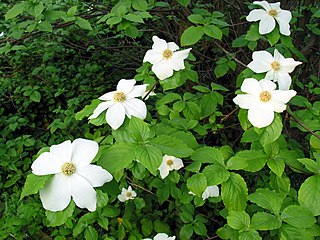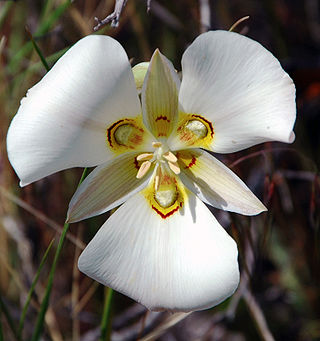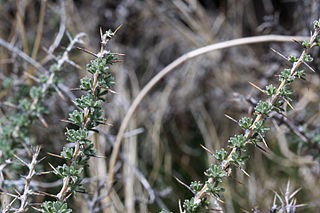
Thomas Nuttall was an English botanist and zoologist who lived and worked in America from 1808 until 1841.

Harperella is a monotypic genus of flowering plants in the family Apiaceae. Its only species is Harperella nodosa, known as piedmont mock bishopweed and harperella. It is native to riparian environments in the Southeastern United States, found at sites in West Virginia, Maryland, several Southeastern states such as Alabama and North Carolina, and the Ouachita National Forest in Arkansas and Oklahoma. As Ptilimnium nodosum, it was placed on the United States' Endangered Species List in 1988.

Cornus nuttallii, the Pacific dogwood,western dogwood, or mountain dogwood, is a species of dogwood tree native to western North America. The tree's name used by Hul'q'umi'num'-speaking nations is Kwi’txulhp.

Amianthium is a North American genus of perennial plants growing from bulbs. It contains the single known species Amianthium muscitoxicum, known in English as fly poison from a literal translation of the Latin epithet muscitoxicum, and is noted for its pretty flowers and its toxic alkaloid content. While all parts of the plant are poisonous, the bulb is particularly toxic. The scientific epithet was given to it by Thomas Walter when he published his Flora Caroliniana in 1788.

Helianthus nuttallii, or Nuttall's sunflower, is a species of sunflower native to northern, central, and western North America, from Newfoundland west to British Columbia, south to Missouri, New Mexico, and California.

Calochortus nuttallii, also known as the sego lily, is a bulbous perennial plant that is endemic to the Western United States. The common name of sego comes from a similar Shoshone word. It is the state flower of Utah.
Laceflower is a common name for several plants and may refer to:

The mountain cottontail or Nuttall's cottontail is a species of mammal in the family Leporidae. It is found in Canada and the United States.

Elodea nuttallii is a species of waterweed known by the common name western waterweed or Nuttall's waterweed. This is a perennial aquatic plant which is native to North America where it grows submersed in lakes, rivers, and other shallow water bodies. It is also found in Eurasia, where it is commonly weedy; it is not known as a weed species in its native range. It is sometimes used as an aquarium plant.

Tiquilia nuttallii is an annual, subshrub-like plant of middle and higher elevation deserts in the family Boraginaceae - borages or the forget-me-nots. It is found in western North America from central Washington to western Colorado, and northern California and northern Arizona; it is also found in a disjunct population in Missouri.

Leptosiphon nuttallii is a species of flowering plant in the phlox family known by the common name Nuttall's linanthus.

Viola nuttallii is a perennial herbaceous plant in the violet family (Violaceae), and is one of the few violet species with lanceolate leaves. It is native to the western Canada and the north-central and western United States, appearing in upper steppe lands, forests, and alpine ridges.

Tetradymia nuttallii is a species of flowering plant in the aster family known by the common name Nuttall's horsebrush. It is native to the western United States, where it occurs in Nevada, Utah, Wyoming, and Colorado.

Toxicoscordion nuttallii is a species of poisonous plant native to the south-central part of the United States.

Lytta nuttalli, or Nuttall's blister beetle, is a species of North American beetle first described in 1824 by Thomas_Say. The genus Lytta is from a Latin word suggesting madness The specific nuttallii recognizes the contributions of Thomas Nuttall, a contemporary of Say.
Nemastylis nuttallii, the Nuttall's pleatleaf, Ozark celestial-lily or pine woods lily, is a plant species native to Arkansas, Missouri and Oklahoma in the south-central United States. Some authors have mistakenly called this species N. coelestina.

Bigelowia nuttallii is a species of North American flowering plants in the family Asteraceae, native to the southern United States.

Cirsium nuttallii, called Nuttall's thistle, is a North American species of plants in the tribe Cardueae within the family Asteraceae. The species is native to the coastal plain of the southeastern and south-central United States, from eastern Texas to southeastern Virginia.

Ptilimnium capillaceum, known by the common name of herbwilliam, is a member of the carrot family, Apiaceae. It is a perennial herb, native to the eastern United States, from Texas to Massachusetts.

Oenothera nuttallii, the white-stemmed evening-primrose, is a species of flowering plant in the family Onagraceae. It is native to western Canada, and the north-central United States, and it has been introduced to Illinois. A perennial reaching 60 cm (24 in), it is found in grasslands, sagebrush steppes, and plains, usually in sandy soils.


















